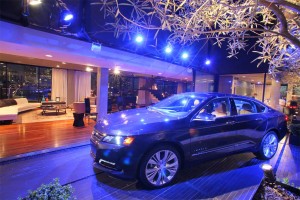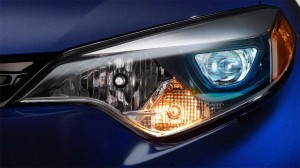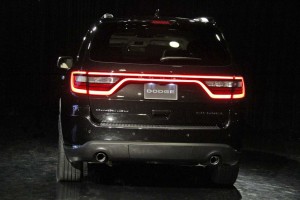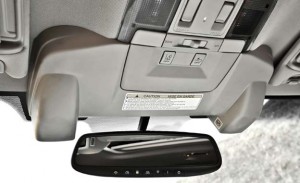When the new 2014 Dodge Durango comes to market later this month, it will offer buyers an assortment of new safety features that include Adaptive Cruise Control, a system that quickly can bring the vehicle to a complete stop in heavy traffic, then start moving again when traffic clears.
The 2014 Chevrolet Impala has a similar system that can slam on the brakes in an emergency, helping avoid an accident the driver might not have time to react to. Meanwhile, Toyota will make super-bright and energy-efficient LED headlamps standard on all versions of the all-new 2014 Corolla sedan.
These and other features, such as the EyeSight system Subaru is rolling out across its model line-up, underscore a dramatic trend in the auto industry, what might best be called “the democratization of technology,” in the words of Ford Motor Co. Chief Operating Officer Mark Fields.
Until now, for example, LED headlamps and radar-guided cruise control and collision avoidance systems have been the sort of features luxury buyers would expect – and often, even then, at a significant option price. But at an ever-faster pace, the latest safety, performance and creature comfort technologies have been migrating down from premium to mainstream, and even showing up on some entry-level models.
(Click Here for the complete 2013 Frankfurt Motor Show round-up.)
The new Nissan Versa Note, the Japanese maker’s smallest model, now features the AroundView Monitor, a system that gives the driver a virtual birds-eye look that makes it possible to see obstacles, whether a curb or a child’s tricycle, otherwise hidden from sight. The same system was first introduced on the maker’s top-line Infiniti brand models.
This democratization is the result of “commoditization,” suggested Tim Kuniskis, the president of Chrysler Group’s Dodge division. Unlike traditional luxury accoutrements, such as leather seats and wood trim, most of the premium technologies that are flooding the market rely on basic electronic components, such as microprocessors and vision, laser, radar and sonar sensors.
And just as with today’s smartphones and other consumer electronics devices, the underlying component costs rapidly plunge as volumes increase.
“So, suppliers may offer a new technology to a luxury maker for a year or two, but then they go mainstream because they need the volume to continue to develop new technology,” explains David Sullivan, an auto analyst with AutoPacific, Inc.
A good example is a system called Cross Traffic Alert, which first was offered on the BMW 7-Series but then appeared, barely a year later, on the 2010 Ford Taurus.
What makes it even easier to migrate new technologies down-market is the fact that many breakthroughs rely on little more than new software to add desirable functionality. When Nissan decided to offer several safety features, such as Blind Spot Detection to mainstream models like the midsize Altima, it was able to skip adding new cameras and sonar or radar sensors, instead relying on the existing rearview camera. All it took was new software code and a low-cost sprayer – much like a conventional windshield washer — to keep the lens clean.
Subaru, meanwhile, did add a new stereo camera for its EyeSight technology, but it was able to use that as an alternative to as many as a dozen other sensors while delivering an array of features including Pre-Collision Braking, Lane Departure Warning, Active Cruise Control and Pre-Collision Throttle Management, among others.
Much of the new technology mainstream motorists are getting these days focus on safety. But there’s been a major increase in the availability of infotainment systems, as well. Even low-end models now feature LED displays, often touchscreen-enabled, as well as HD and satellite radio systems.

The 2014 Chevrolet Impala will jam on the brakes even if the driver is slow to recognize an emergency.
One area where prices have remained stubbornly high is with in-car navigation systems, and on many vehicles, it is still an option of more than $1,000. But prices are beginning to tumble, in part because so many vehicles already feature the requisite touchscreen displays, anyway. Some versions of the little Chevrolet Spark minicar can add a navi feature for about $50. In this case, the maker uses a novel approach, replying on a linked smartphone app, rather than software actually embedded in the vehicle itself.
(VW goes electric. Click Here for the full story.)
The 2014 Toyota Corolla benefits from the rapid decline in price in LED technology. While it’s the first mid-level model to make the energy-efficient lighting system standard, few expect it to stand alone for long. The new Durango, meanwhile, uses 192 smaller LEDs to illuminate its so-called “racetrack” taillights.
“LED costs are falling rapidly,” as are other premium lighting technologies, notes Joe Dehner, a senior Chrysler designer.
The new BMW i8 plug-in hybrid sports car will offer the latest breakthrough, laser lighting. Industry observers say they wouldn’t be surprised to see that in midrange models well before decade’s end.
How far will this democratization trend go? Both Cadillac and Mercedes-Benz are pushing to develop autonomous, or self-driving, vehicles. But Nissan has already committed to bringing a fully autonomous vehicle to market by 2020. And rather than offering it on a premium Infiniti model, global product development chief Andy Palmer last month promised it will debut on an “affordable” model, most likely the next-generation version of the Nissan Leaf battery car.



